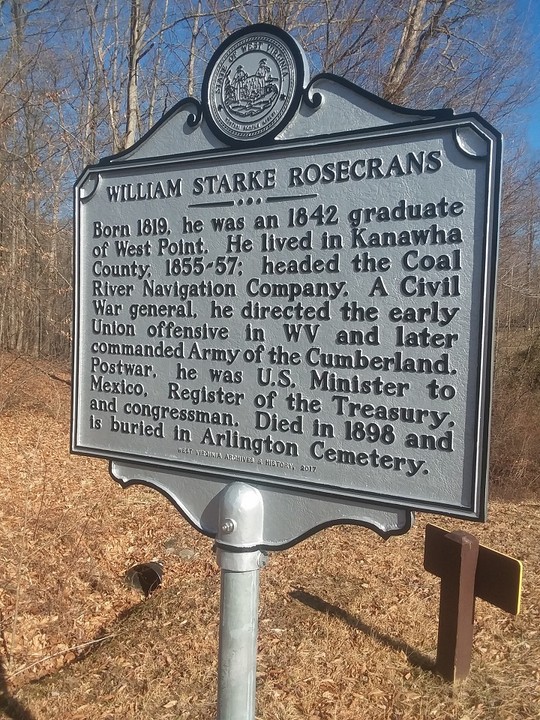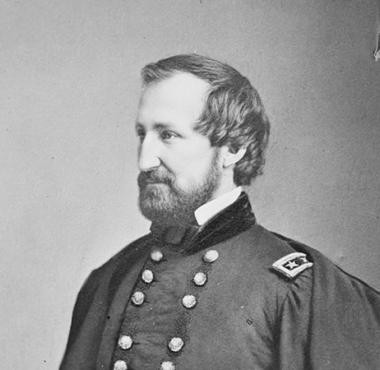William Starke Rosecrans Highway Historical Marker
Introduction
Text-to-speech Audio
Images
William Starke Rosecrans Highway Historical Marker

William Starke Rosecrans

Backstory and Context
Text-to-speech Audio
William Starke Rosecrans was born in Delaware County, Ohio on September 6, 1819. His father, Crandall Rosecrans, was a veteran of the War of 1812, having served under the command of future U.S. president William Henry Harrison. A bright young man, Rosecrans was admitted to the United States Military Academy at West Point in 1838 and graduated near the top of his class four years later. In 1843, he married Anna Elizabeth Hegeman. Rosecrans taught at West Point from 1843 to 1847 before being assigned to work on various engineering projects across the country. In 1854, due to poor health, he resigned from the military, leaving with the rank of First Lieutenant. Over the next several years, Rosecrans worked as an architect and civil engineer in Ohio and Virginia, and secured several U.S. patents. Between 1855 and 1857, he resided in Kanawha County, Virginia (now West Virginia).
When the Civil War broke out in the spring of 1861, Rosecrans joined the staff of General George B. McClellan. A few months later, he was commissioned a colonel and placed in command of the 23rd Ohio Infantry. Soon after, he was promoted to the rank of brigadier general. Throughout most of the summer of 1861, he fought under McClellan’s command during the successful Union offensive in western Virginia. Following the Union disaster at Bull Run in late July, President Abraham Lincoln brought McClellan east to take charge of the Army of the Potomac, leaving Rosecrans in command of federal forces in the area. Several months later, in the spring of 1862, he was transferred west to command a portion of the Army of the Mississippi led by General John Pope. In the summer of 1862, Pope was transferred east to take command of the Army of the Potomac and Rosecrans once again inherited an army. Commanding the Army of the Mississippi, he secured impressive victories at Corinth in September and Iuka the following month, but angered General Ulysses S. Grant—who at the time was the commander of all federal forces in western Tennessee—for not pursuing the defeat Confederates. Rosecrans’ success in Mississippi earned him a transfer to Kentucky, where he took command of the Army of the Cumberland. In June 1863, he led an offensive that drove Braxton Bragg and the Army of Tennessee from Chattanooga and into northern Georgia. Once again, Rosecrans failed to pursue a defeated Confederate force. In September, Bragg attacked Rosecrans near Chickamauga Creek, forcing the latter to retreat and dig in at Chattanooga. Following the embarrassing defeat, General Grant had seen enough and relieved Rosecrans of his command, a decision which left the latter incredibly bitter. During the final years of the war, Rosecrans led federal troops in Missouri, but never regained the standing he lost after Chickamauga.
In 1867, Rosecrans resigned his commission and the following year President Andrew Johnson appointed him U.S. Minister to Mexico. After serving in that role for a year, he resigned and moved to California, where he began a political career. In 1880, Rosecrans was elected to the U.S. House of Representatives, ultimately serving California’s First Congressional District for two terms. On March 11, 1898, he died and was buried in Rosedale Cemetery in Los Angeles. In 1902, his remains were exhumed and reinterred in Arlington National Cemetery.
In 2017, the West Virginia Highway Historical Marker Program of the West Virginia Archives and History, as part of its Civil War sesquicentennial project, installed a marker dedicated to William Starke Rosecrans. It stands along U.S. Route 119 inside Forks of Coal State Natural Area in Kanawha County.
Cite This Entry
Brown, Cody and Francis Curran. "William Starke Rosecrans Highway Historical Marker." Clio: Your Guide to History. September 5, 2020. Accessed August 14, 2025. https://theclio.com/entry/96436
Sources
Lamers, William M. The Edge of Glory: A Biography of William S. Rosecrans, U.S.A. Baton Rouge: Louisiana State University Press, 1999.
"William Rosecrans." National Park Service. 12 February 2018. U.S. Department of the Interior. Web. 3 Sept. 2020. <https://www.nps.gov/people/william-rosecrans.htm>.
"William S. Rosecrans." American Battlefield Trust. Web. 3 Sept. 2020. <https://www.battlefields.org/learn/biographies/william-s-rosecrans>.
West Virginia Archives and History. <http://www.wvculture.org/history/markers/sesqui/williamstarkerosecrans.html>.
American Battlefield Trust. <https://www.battlefields.org/learn/biographies/william-s-rosecrans>.

